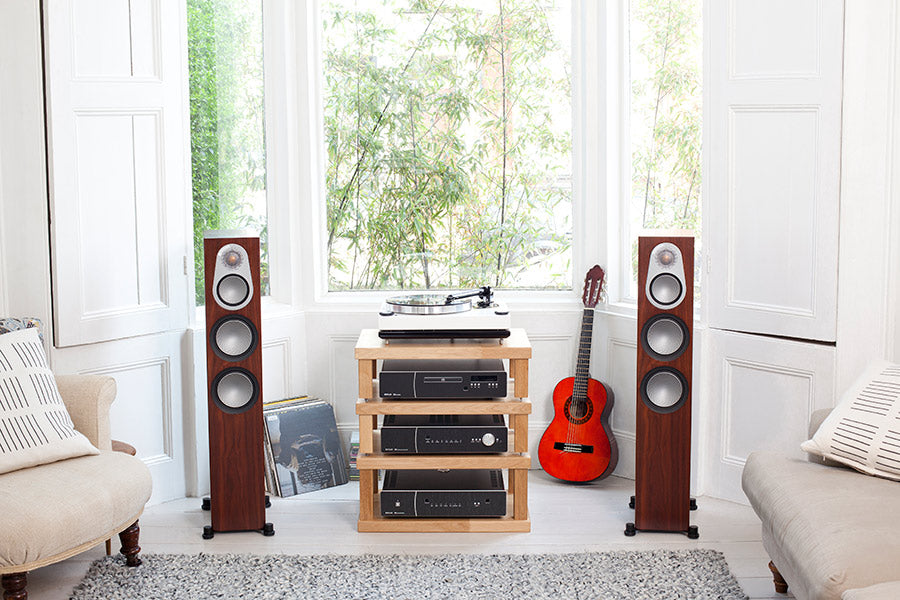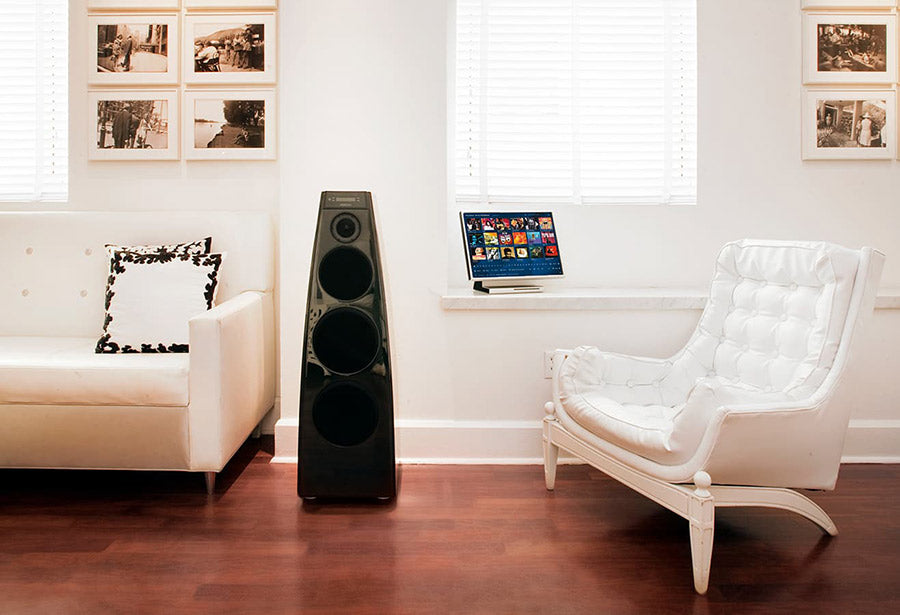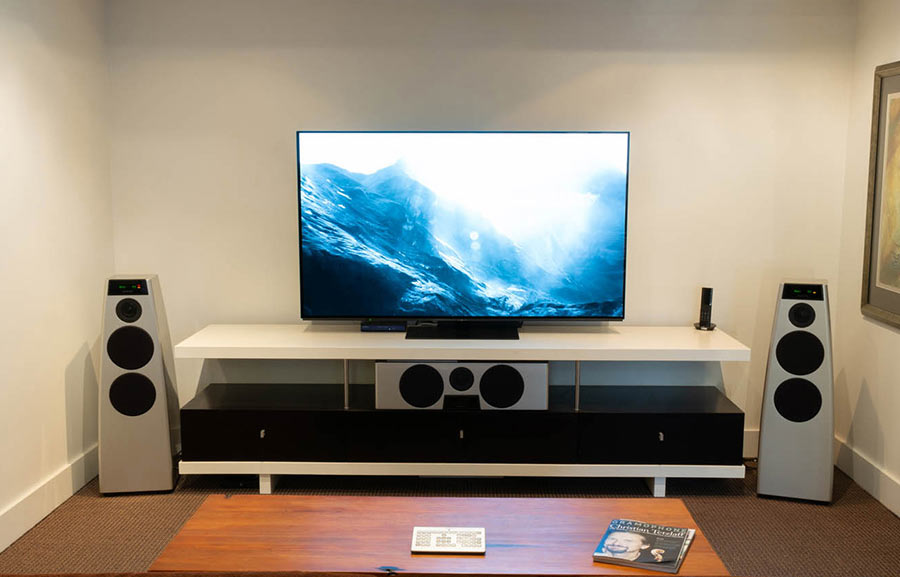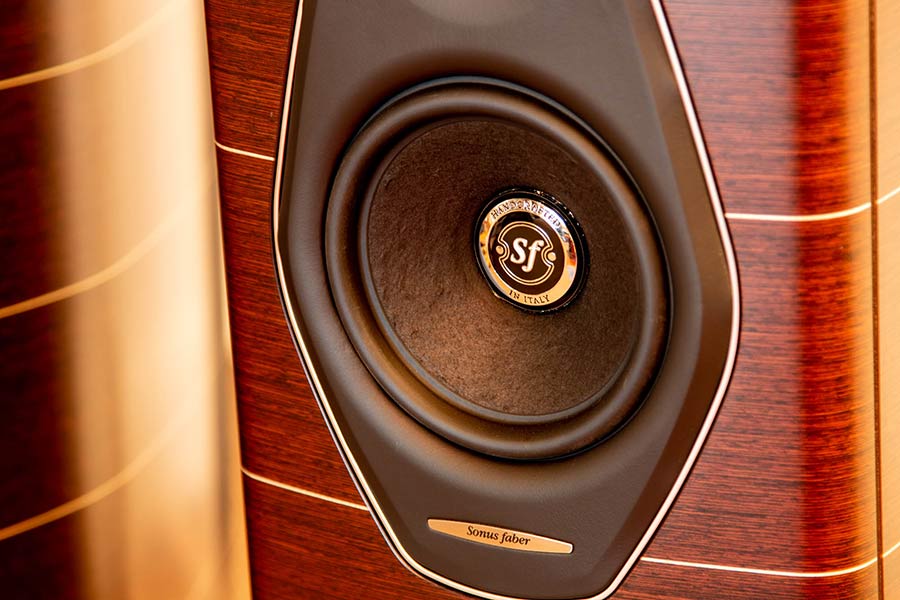Buying a set of speakers for your hifi or home theatre system sounds easy right? Find the biggest ones with the most Watts and you're all set. Anyone who's spent some time researching speakers before purchasing will tell you there's a whole lot to learn and many things to consider. Spending some time on research now will mean you end up with speakers that suit your needs and you'll be happy with for years to come.
With that in mind, let's take a look at some of things you should ponder before you make the leap into the world of loudspeakers.

What will you use them for?
Before you start thinking about brands, drivers, specs or power ratings, put some thought into what you actually need your speakers to do. Will they be dedicated hifi speakers, used in a surround home theatre setup or both?
The simplest place to start is the humble soundbar. If you're just looking to beef up the sound for your TV and movie watching, then a soundbar could provide what you need with minimal outlay. This will certainly sound better than inbuilt TV speakers and you'll have some budget left for more of those streaming subscriptions or a Roon setup.
Or, you could splash out a little more and move into more of a surround sound system. These can start simple with a 2.1 system that you can build out later to a 5.1, 5.2, 7.2 or as far as your room, budget or significant other allows.
If you're a keen music listener, then you might look at a pair of smaller bookshelf speakers. These can produce excellent sound and take up very little space. If you decide you're lacking a little bass, then this is easily resolved with the addition of a separate subwoofer (or two).
If you take your listening really seriously, then you may consider moving up to a set of floorstanding speakers. With multiple drivers, these can produce full and clear sound while also looking amazing.
Of course it's perfectly ok to use a pair of hifi audio speakers to provide your movie soundtracks, just like a 7.2 surround system will play music well. It's just a case of thinking about what your priorities are, and how you'll be using your speakers the most.
Music type
What you like to listen to can have an impact on your choice of speaker. Some will naturally provide more bass and be well suited to heavier rock music, while others will be extremely detailed and may do an excellent job of playing classical music. Some models may require the addition of a sub to achieve the sound you want, while others may be fine on their own. The amplifier you pair your speakers with will also make a difference and is another variable to consider.

The best way to determine how your music sounds on different brands or models of speaker is to simply try them. Reading reviews and endless discussions about what to choose are no substitute for actually sitting down and playing music. This is where your relationship with your local hifi store will pay off. Take along some music that you know well and listen to a few different speakers to get a feel for how they sound. If you're buying speakers to use in your home theatre and your store has a theatre demo room then make the most of it. It's also worth taking the time to make sure you have your music available at high quality. Although portable media devices offer convenience, the music they carry is usually highly compressed and will be missing a lot of detail. Take some music on CD or check if your store has access to high quality streaming options. It's a good idea to choose music that will cover a few different areas such as strong bass, strings, vocals, quiet passages etc. It's good to use music you're familiar with so you're more tuned to picking up differences and you will quite likely hear new parts in the music you've never even heard before.
Take reviews and opinions with a grain of salt too. Usually these will be the findings of a single person and while a particular model may have worked well for them, they could be quite unsuited for your circumstances. Let your ears be the final judges.
Take your time when you're listening and give yourself a chance to adjust to the new speakers. Jumping between sets of speakers is a good way to weed out obviously unsuitable candidates, but try and remember to sit back and give each set a fair audition. Some speakers will sound good in the beginning but over time can become tiring to listen to, so listening time is crucial to long term satisfaction.
Location
Your listening environment will have an influence on the range of speakers you can choose from. The obvious limitation is room size and it makes little sense to add large floorstanding speakers to a small room, besides wasting money you'll probably never use them to their fullest extent and will probably overload the room with bass. Look at the footprint the speakers will occupy and consider how that might influence your choice. Bookshelf speakers might be smaller, but on stands will take up almost the same area as floorstanders.
Take into account any manufacturer recommendations on spacing speakers away from a wall. Most speakers require some free space around them to achieve their best sound, so be sure to consider this when measuring your room. There are some models that don't require much free space to perform well, but in general, large floorstanding speakers require at least 20cm from the rear wall and 70cm from side walls.
Remember that if you're unable to position your speakers correctly you simply won't get the sound you're paying for.
FINISH
Think first about the finish any candidates are available in. You might have some regrets if you purchase on specifications alone only to discover that once delivered the speakers don't suit your room. Remember that you have to live with them in plain sight so they may as well be something you enjoy looking at. Don't forget that something that suits your decor may also help gain approval from a significant other.
CONSTRUCTION
The materials and methods used to build a speaker will have a definite impact on its final sound. The job of the cabinet is to absorb stray vibration and let the speaker driver do its thing. A weighty, solid speaker cabinet will do a much better job of this than a light and flimsy one. A knuckle tap on the side of the cabinet will give you a quick indication of how solidly built they are. Ideally you'll hear a dull thud indicating good levels of absorption.
Passive, powered or active?
Most speakers are what's known as passive. They require some sort of external amplifier to drive them and produce sound. The advantage of this type is that you have control over the amplifier used, which will have an influence on the sound quality.

A powered speaker has the amplifier already built into the cabinet meaning you connect a cable carrying the music signal from your source, and also a power cable. These speakers also have a crossover built in which takes the amplified signal and splits it into high and low frequencies before feeding those signals to the appropriate drivers. Low frequencies go to the larger woofers while the high frequency signals go to the smaller tweeters.
The third type are active speakers. These are similar to powered models, except each driver has it's own amplifier. The splitting of the audio signal into high and low is done before amplification meaning more finely tuned components can be used, improving sound quality.
The main drawback with powered and active speakers is that you're locked into the on-board amplifier. If you want to upgrade either in the future you're forced to replace both. In general the best sound comes from an external amplifier but powered/active speakers can be a good option where space is limited or you want to reduce complexity.
But what are all these numbers?
Speakers don't exist in isolation. The amplifier they're paired with makes a big difference to the final sound. When talking about speakers it makes sense to give some consideration to the amp/speaker pairing. There are a lot of numbers thrown around in the audio world and this is certainly true when we think about speakers and amps.
Impedance
Matching amplifiers and speakers is less important these days but there are a couple of things to keep in mind. First you'll want to make sure that your amp can drive your speakers safely and effectively. Speakers have a characteristic called 'impedance'. You'll see this figure written on the back of a speaker somewhere and it's a measure of how much resistance the speaker puts up against the signal being sent to it by the amp. If this impedance is too low, the amplifier can overheat and become damaged. These days a majority of speakers are rated at 8Ω (Ohms) and will likely work fine with any amp. This is only really becomes a consideration if you're thinking about low-impedance speakers like 4Ω or 6Ω.
Power
Power levels in amplifiers and speakers are measured in Watts just like other electrical equipment. When it comes to hifi and home theatre amplifiers, power is often quoted in two forms. The first is Continuous Power (or RMS) and is an indication of how many watts an amplifier will deliver consistently over time. The other is Dynamic or Peak power and indicates how much power the amp can supply during moments of peak demand. The duration of this supply is very short however and not the best indicator of amplifier power. The bottom line then is to pay attention to the Continuous Power rating and make sure it matches the recommended power levels for your speakers. More power isn't necessarily better, it's the match between amplifier and speaker that's important.
One word of caution here. Just as it's bad to overpower a speaker, it's also not a great idea to underpower it either. Using an amplifier that's well under the power rating of the speaker means you'll continue to increase volume, overheat the amp and start sending clipped signals to your speaker. This creates a lot of distortion and high frequency energy that can damage both the speakers and amplifier.
Sensitivity
Sensitivity is a measurement of how loud a speaker will be per watt of power supplied to it and is probably the most important spec to consider. Going for a speaker with higher sensitivity is good because the output of an amp will have to double to gain an additional 3dB. So if you have a low powered amp, look for speakers with a high sensitivity rating. That doesn’t mean higher sensitivity is necessarily better, it simply means that a higher sensitivity speaker will need less power reach a given volume, and potentially save you from investing in a more powerful amplifier. A good guide here is around 80dB to 88dB per watt for an entry level speaker, and around 89dB to 100dB per watt for higher end models.
Frequency response
The frequency response of a speaker describes the range of tones it can produce and may read something like 32Hz - 35kHz. The first number tells you how low the speaker goes and the second number indicates its upper limit. The wider this number, the fuller the sound of the speaker will be.
Pairing
The other consideration and one that's much harder to measure is the way amplifiers and speakers work together to produce a certain sound. Different models of amps and speakers all have their individual sounds and these will change when paired together in different ways. This is where some experimentation will come in, along with help from that local hi-fi retailer. Talk to them about what you're trying to achieve and let their experience with many different makes and models do the hard work for you. If you can use your existing amplifier when auditioning speakers that removes another variable and brings you closer to the sound you'll hear once you get everything into your own home.
Building your system
It's perfectly ok to build your system out gradually. A common way is to start with a two speaker setup which will work well for music and theatre and then add a centre channel, surrounds or a sub as your budget allows. We would recommend sticking to one brand if possible. As the sound will differ between brands, you're best to take advantage of the fact that speakers from one brand will all have the same sound signature. This is especially important in a home theatre situation where you want the sound to remain consistent all around.
The exception to this is the subwoofer. There are companies that specialise in making these and do an excellent job of it. The sub is an important part of a good home theatre system and it's worth putting some effort into finding what works for your situation. It's also common for good systems to have two smaller subs instead of one large one. Having two subs will help to eliminate any dead spots in the room and ensure the same great experience no matter where in the room you're sitting.

Types of speakers
Soundbar
Todays TV's look great with thin screens, but unfortunately this leaves little room for speakers. Soundbars are the probably the easiest and cheapest solution to this problem. Soundbars are long, thin enclosures that contain several speakers and the electronics to run them. Usually they sit just in front of your TV and provide a cheap and easy upgrade to the audio provided by your TV.
When it comes to channels, soundbars will attempt to replicate most of the existing home theatre configurations such as 2.1, 5.1, 7.1 and so on. The difference is that they do it within a single box and the general rule is the more channels the better. Obviously there's a compromise in this single box solution and although they won't give you the same experience as a full home theatre system they are a great option if you have limited space or budget.
Modern soundbars provide a good number of connectivity options with the best being HDMI ARC, which lets you connect your soundbar to your TV with a single HDMI cable, job done. Bluetooth an Wi-Fi options are also available should you wish to connect your phone or table to them. Optical connections are another way to connect your TV and soundbar, however full 5.1 audio is often not possible with this method.
Soundbars also come in active and passive models. Active means they come with a built in amplifier and the processors to separate the incoming signal to the correct speakers. Passive variants require a separate amplifier or receiver to work. They will probably have better speakers however, which means better sound.
If you don't have room in front of your TV for a soundbar you could consider a sound base. These are basically the same except your TV will sit on top of them. They have a little more room in side so may include slightly larger speakers or amplifiers. Because they are physically smaller than soundbars, they won't be able to achieve the same degree of separation in the sound which is a slight drawback.
Surround
It might help to think of surround speakers in terms of placement rather than a type of speaker as there are a range of options for the job.
Bookshelf speakers are commonly used in a surround role. Their size makes them easy to place on stands or rear walls and their sound quality will be second only to towers.
Satellites are smaller lower power speakers designed to provide additional presence and surround sound. They're usually fairly small and have the job of reproducing medium and high frequency sound. They're an addition to a main set of speakers and come in 2.1 and 5.1 systems. The first number indicating the number of satellites, the second representing a subwoofer. Easily integrated with stand or wall mounts, satellite speakers are a relatively cheap way of filling out the sound in your room and adding dimension to a home theatre.
Bipole or dipole speakers are angular looking speakers that have drivers firing in different directions. These are great at dispersing sound throughout a room and as such, are a good choice when the speakers are close to the listening position. Switchable between bipole and dipole, this speaker type offers flexibility in rooms where speakers are tricky to place due to doors, windows or walls.
Architectural
Architectural speakers are mounted in-ceiling or in-wall and are designed to provide seamless audio integration within a home. These can be used to provide music to different rooms in the home, or act as height speakers in a home theatre setting to provide additional atmosphere and spaciousness to the sound. These speakers often come without a cabinet, with the wall cavity fulfilling this role.
Use of these speakers requires a little more planning as installation will require some building work. Because of this, it's important to get them position correctly the first time around and this is something we can help with. We can look at your room dimensions, intended use and other equipment before recommending exactly where to install this type of speaker. There's a lot of research necessary to achieve best results and we're more than happy to offer advice.
Floorstanding
Floorstanding speakers are at the larger end of your options. They're generally reasonably big and heavy which makes them good at absorbing extra vibration and filling the room with rich, full sound. These will generally have more presence than a set of smaller bookshelf speakers with the same drivers due to their extra volume. Floorstanding speakers are usually the type favoured by those chasing the best sound possible but they can offer great value at any performance level and are the most popular type.
Floorstanding speakers will have several drivers, each responsible for a certain frequency range. Tweeters will cover frequencies around 2,000 to 30,000Hz, and midrange drivers around 500 to 2000Hz. Lower frequencies are handled by woofers (40 to 1000Hz) and subwoofers (20 to 200Hz).
Although they rest on the floor, these types of speakers often rest on small spikes designed to minimise the transfer of any unwanted vibration. This can be a particular problem with suspended wooden flooring which can lead to unwanted reverberation.
Bookshelf
Think of bookshelf speakers almost as mini floorstanders. They'll fit into smaller spaces, hence their name but can really be placed anywhere. They're a great upgrade from a soundbar if you're looking for some extra punch when watching movies, and also do a great job playing music with a two channel system.
Actually placing bookshelf speakers on a bookshelf would seem like the most logical thing to do, but most people use some form of stand for mounting. Bookshelf is more a descriptor of their size rather than final resting place and stand are probably going to produce far better quality sound as well. Thanks to their smaller size, these types of speakers can also be wall mounted quite successfully. Great if you're pushed for space or have young children who present a risk of knocking over stand mounted speakers.

Centre
When movie soundtracks are mixed for surround sound, the vocals are usually given their own channel. This can cause a problem when playing back on a two channel system, in that this vocal track is split between the two channels and direct control over its volume is lost. Sometimes vocals or dialog can be hard to hear and there's no ability to adjust accordingly. Adding a centre speaker will allow for more clarity and volume from the vocal track.
If you're adding a centre speaker to some existing floorstanding or bookshelf speakers then we recommend sticking with the same brand if possible. They will have matching sound profiles which is great for when the sound sweeps across the room and all of your speakers react together and create a tight, immersive effect. This is known as timbre matching and can make a genuine difference to your viewing experience.
Subwoofer
If you fee like your current audio or home theatre system is lacking punch or depth then the addition of a dedicated subwoofer could make a difference that you feel as much as hear. Subwoofers are usually square-ish boxes with their own power supply dedicated to providing low-end bass notes.
The two main areas to consider when looking for a sub are size and power. Driver sizes are commonly in the 10-30cm range and cabinets will be reasonably generous in size to reach best performance. There are no hard and fast rules around sub size, but generally larger and higher power is better. You're better off running a large sub at '4' than a smaller sub at '10'.
Power follows the same general rules as other speakers. Look at the continuous power a speaker is rated for, not the peak power. Remember, these figures are just an indication of how much power a sub can handle, they're not always representative of quality. For any size room 100 watts is probably to minimum power to consider. A well designed 10cm, 100w sub may well sound better than a 15cm, 250w sub, so this is where research, reviews and talking to your local hifi shop is time well spent.
Often subwoofers will have their own volume control which you can fine tune as needed.
Still think that buying a set of speakers is easy? There's certainly plenty to think about but don't worry, you're not on your own. Soundline have years of experience in selecting speakers for many different situations, and we're more than happy to offer that advice to you. Take some time, do your homework and use our free advice to make sure you end up with speakers that you'll continue to get enjoyment from for many years to come.
